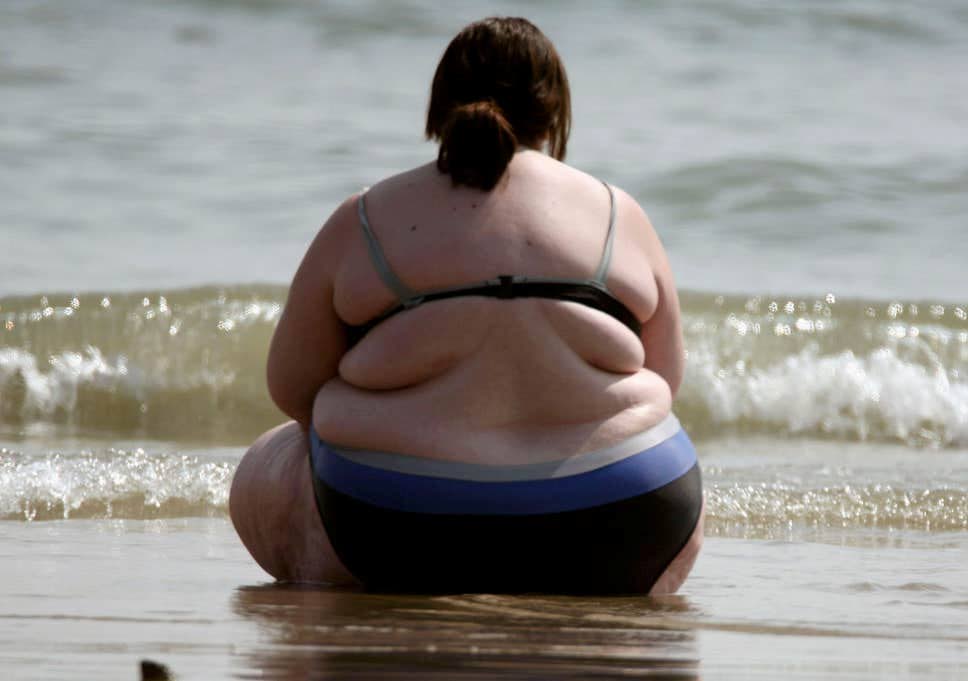Fat: More to love…or more to fear?

SHEREEN ALI
When you have a fat friend, there are no see-saws, only catapults – comedian Demetri Martin
Fat can shiver delicately, jiggle playfully, or hang in ominous, implacable folds around your belly, weighing down your life. Fat, in the right places, can be a tantalising attraction; in the wrong places, fat can be a source of shame. Fat is an essential healthy part of body flesh and the physical self, without which none of us can survive; yet too much of a good thing can harm us. Like much in life, it’s all about the balance.
In TT, according to 2016 data from the World Health Organization, 48.1 per cent of all TT adults (18 and over) are overweight. By gender, they found 38.7 per cent of men were too fat and 57.1 per cent of women. While TT did not make the WHO’s top 20 most overweight countries in the world list (which is topped by Oceania, where a whopping 75-88 per cent of their people are overweight), our own high figures, with almost half of our population too fat, are worrying.
So what exactly is “too fat” or “overweight”? According to the Centers for
Disease Control and Prevention (CDC), weight that is higher than what is
considered as a healthy weight for a given height is described as
overweight or obese. Body mass index, or BMI, is used as a screening tool
to assess overweight or obesity in adults. Body Mass Index (BMI) is a
person’s weight in kilograms divided by the square of height in metres. A
high BMI can be an indicator of high body fatness. The CDC advises:
• If your BMI is less than 18.5, it falls within the underweight range.
• If your BMI is 18.5 to <25, it falls within the normal.
• If your BMI is 25.0 to <30, it falls within the overweight range.
• If your BMI is 30.0 or higher, it falls within the obese range.
Obesity is frequently subdivided into categories:
• Class 1: BMI of 30 to < 35
• Class 2: BMI of 35 to < 40
• Class 3: BMI of 40 or higher. Class 3 obesity is sometimes
categorised as “extreme” or “morbid” obesity, with individuals 100
pounds or more over their ideal body weight.

What is fat?
So what exactly is fat? A 2013 report by the National Institute of General Medical Sciences (NIGMS) states that in human plasma alone, there are some 600 different types of fats or lipids relevant to health.
According to a 2013 TED-Ed video by George Zaidan, the fat in human bodies is made up of molecules called triglycerides. Triglycerides are fats (or lipids) in the blood which store unused calories and provide the body with energy.
Lipids come in many different forms. Some are saturated with hydrogen and are usually solid at room temperature, while unsaturated fats are often liquid at room temperature. Cholesterol is yet another kind of fat used to build cells and certain hormones.
“Many lipids are associated with diseases – diabetes, stroke, cancer, arthritis, Alzheimer's disease, to name a few. But our bodies also need a certain amount of fat to function, and we can't make it from scratch.” (NIGMS report).
Why it’s good
Fat is important. The fat tissue in women’s breasts ranges from ten to 90 per cent, and ovulation is tied to a woman’s fat stores: women who are too thin may simply fail to menstruate. The Arc Fertility Clinic in Cupertino, California, reports: “Sex hormones are fat soluble and they are stored in the body’s fat layers. Women (who) have a low BMI produce a reduced amount of oestrogen which can lead to an abnormal menstrual cycle. Amenorrhoea, or the lack of a menstrual cycle, is a result of a low BMI.”
Bodies all need fat to be conceived in the first place, to function after birth, and to help prevent disease throughout life. Fat does many good things. It provides a cushion that helps protect the vital organs. It acts as an insulator, helping to maintain a proper body temperature. Fat also enables bodies to process vitamins A, D, E and K, which are all fat-soluble and vital to good health. People need certain essential fatty acids which they must obtain from the food they eat because the body does not make them.
Fat, of course, also makes many foods taste so much better. Crispy fried chicken, mashed potatoes slathered in oceans of butter, sweet creamy desserts and puddings, piquant curry sauces rich with meat oils or fatty vegetarian cheeses, macaroni pie or lasagnas that melt in your mouth, and Christmas ham fragrant with clove-infused melted hog dripping would certainly not be as scrumptious without the unique special deliciousness of fat.
Why too much is bad
Some fat in the body is a very good thing. But many doctors say problems arise when people consume and their bodies store too much fat. Many doctors agree that poor food choices over time, including eating too many “bad” fats of the wrong type, without using up most of that extra energy, are one sure way to ill health.
Fat is a concentrated source of energy; one gram of fat has nine calories, much more than a gram of protein or carbohydrate, which each contain only four calories. So it is very easy to consume too many calories when eating fatty foods, especially as fatty goods often taste so good. The body will simply store the unused calories as fat.
While it is theorised that in ancient times, human bodies evolved to store fat in order to survive the leaner times when food would become scarce, in many parts of the modern world, seasonal famine is no longer so widespread. This means that, especially in sedentary urban cultures where people are not active or do not exercise, their bodies store fat all year round but never burn it off, leading to their becoming overweight or, in extreme cases, obese.
“Obese” simply means fat that has become so voluminous and abundant that it is unhealthy, putting people at higher risk for a host of ailments and fat-related diseases. When people have a body mass index (BMI) of 30 and above, they are considered obese.

Prof Dilip Dan: Too much fat makes you sick
Prof Dilip Dan, head of the Department of Clinical Surgical Sciences at UWI and Caribbean pioneer in laparoscopic and bariatric surgery and president of the Caribbean Obesity Society, in an interview with Newsday, said excessive fat is directly related to increased diseases and deaths from diabetes, hypertension, heart disease, and cancer. There is also a clear link between too much fat and conditions such as infertility, gastro-oesophageal reflux, obstructive sleep apnea, joint and back pain and many other conditions, he said.
“It is not only excessive amount of fat that matters but also the distribution of the fat,” noted Dan. “The central or abdominal fat is considered worse, as it is strongly associated with metabolic disorders like diabetes and hypercholesterolaemia. Though peripheral distribution of fat is not as bad with regards to metabolic disorders, it causes strain on the heart, joints and back and can lead to significant disabilities.”
He added: “Because the central distribution of weight is considered more dangerous, persons who may not appear very obese to the eye can be at very high risk for death due to metabolic diseases. This is very apparent in the East Indian and Chinese population, who develop diabetes and heart disease at a much lower BMI than the Caucasian and Afro-Trinidadian. It is for this reason the international bodies have lowered the weight classification on degree of obesity in this population.”
So can’t some people be fat and healthy?
Dan said although there is indeed such as thing as “healthy obese,” it only applies to “very well compensated, usually younger obese individuals who have not developed any health issues as yet.” Given time, these individuals, too, will fall ill if their weight does not go down, he said.
What about slim people who have high cholesterol? Dan said: “This is not just related to weight, but diet and also genetics. In the same way, obesity is strongly associated with diabetes, but one does not need to be obese to have diabetes.”
Dan also noted: “Increased weight can lead to poor self-esteem and depression and in addition to the many co-morbidities, directly affects the quality of one’s life.”
Fat can shrink brain volume
Excess fat can also affect your brain, especially if you are a man. A recent study from Leiden University Medical Centre in the Netherlands found that higher levels of body fat were tied to lower brain volumes in certain areas. Specifically, too much body fat was linked to reduced amounts of grey matter – the brain tissue that contains nerve cells – in structures in the centre of the brain. The link between body fat and brain volume was stronger among men compared with women, according to the study, which was published on April 23, 2019 in the journal Radiology.
The Leiden University Medical Centre researchers also saw changes in the brain's white matter – long nerve fibres that allow areas of the brain to communicate – tied to body fat.

It’s not how much fat you eat, it’s what kind
One thing most scientists agree on is that it’s not so much the amount of fat people eat, but what kind of fat they eat that most affects their weight, cholesterol or risk of heart disease and other ailments. A February 2015 article by the Harvard Medical School, updated in 2018, noted: “For long-term health, some fats are better than others. Good fats include monounsaturated and polyunsaturated fats. Bad ones include industrial made trans fats. Saturated fats fall somewhere in the middle.”
The Harvard Medical School article says trans fat is the worst possible type of dietary fat: “It is a by-product of a process called hydrogenation that is used to turn healthy oils into solids and to prevent them from becoming rancid. Trans fats have no known health benefits and there is no safe level of consumption.”
So which foods contain trans fats? Think doughnuts, cookies, pies, cakes, coffee creamer, vegetable shortenings, refrigerated dough products, fried chicken, French fries and most fast foods, including frozen pizza. It’s a good idea always to check the nutrition part of the label. If it contains partially hydrogenated oils, it has trans fat.
The Harvard Medical School article warns: “Eating foods rich in trans fats increases the amount of harmful LDL cholesterol in the bloodstream and reduces the amount of beneficial HDL cholesterol. Trans fats create inflammation, which is linked to heart disease, stroke, diabetes, and other chronic conditions. They contribute to insulin resistance, which increases the risk of developing type 2 diabetes. Even small amounts of trans fats can harm health: for every two per cent of calories from trans fat consumed
daily, the risk of heart disease rises by 23 per cent.”
…but some fats are good for you.
Sugar may be the real villain.
There is good news in the trenches of fat warfare. So-called “good” fats (monounsaturated or polyunsaturated) come mainly from vegetables, nuts, seeds, and fish, and can be a healthy part of your regular food. And there are increasing views that fat in itself is not necessarily the real villain in one's diet; a little butter or the occasional fried chicken leg won’t kill you. Much greater dangers may come from eating food with too many hidden added sugars and refined carbohydrates – which includes many processed food products in groceries.
Eminent but controversial UK cardiologist Dr Aseem Malhotra is a passionate anti-sugar advocate who promotes a sugar-free, low-carb, moderately fatty diet as the path to good health. While he sees nothing wrong with the occasional treat, he says sugar should never be part of any recommended regular daily diet. Malhotra believes all nations should regulate sugar in the same way they do tobacco, because people are becoming too sugar-addicted, with bad health consequences. (See his persuasive article here: https://www.menshealth.com/uk/nutrition/a755000/the-truth-about-fatand-sugar-is-finally-explained/)
So the message is: Be more aware of what you eat for your own long-term health. You can save yourselves thousands of dollars in medical bills if you learn to eat more healthily as a routine part of your daily life. Healthy, nutritious whole food is indeed the most basic form of self-care and medicine – as the ancient Hindu Ayurvedic practitioners were keenly aware of and put into practice many thousands of years ago.
Next – Part 2: Why are people getting so roly-poly? Reasons for ballooning weight problems
How do you calculate your BMI?
Body Mass Index is a person’s weight divided by their height in units squared and is a quick way of estimating a person’s body fat. The formula is BMI = kg/cm², where kg is a person’s weight in kilograms and cm² is their height in centimetres squared. The WHO defines being overweight as having a Body Mass Index of 25 or greater.
Obesity is defined as a BMI of 30 or greater. BMI is not a perfect test, nor is it a measure of health: it is simply a measure of size. BMI results can be thrown off by pregnancy or high muscle mass, and it may not be a good measure of health for children or the elderly. Critics of BMI say BMI does not distinguish between fat and muscle. Also, BMI does not reveal different types of fat: belly fat, which is known as visceral fat, is more harmful than fat that simply sits under the skin.
What are the world’s fattest countries?
24/7 Wall St – a Delaware firm which runs a financial news and opinion company with content delivered over the Internet – reviewed WHO's 2016 BMI data for adults in 195 countries. They found the 20 countries with the largest percentages of adults (18 and over) who are overweight (defined as a BMI of 25 and over) are located almost entirely in Oceania and the Middle East.
The 24/7 Wall St review ranked the top 20 fattest countries, based on 2016 data, as follows:
1 Nauru, Oceania – 88.5% overweight
2 Palau, Oceania – 85.1%
3 Cook Islands, Oceania – 84.7%
4 Marshall Islands, Oceania – 83.5%
5 Tuvalu, Oceania – 81.9%
6 Niue, Oceania – 80 per cent
7 Kiribati, Oceania – 78.7%
8 Tonga, Oceania – 78.5%
9 Samoa, Oceania – 77.6
10 Micronesia, Oceania – 75.9%
11 Kuwait, West & Central Asia – 73.4%
12 Qatar, West & Central Asia – 71.7%
13 Saudi Arabia, West & Central Asia – 69.7%
14 Jordan, West & Central Asia – 69.6%
15 Lebanon, West & Central Asia – 67.9%
16 United States, North America – 67.9%
17 United Arab Emirates, West & Central Asia – 67.8%
18 Libya, West & Central Asia – 66.8%
19 Turkey, West & Central Asia – 66.8%
20 Malta, Europe – 66.4%
(Source: https://247wallst.com/special-report/2018/07/11/the-worlds-mostoverweight-countries/)


Comments
"Fat: More to love…or more to fear?"